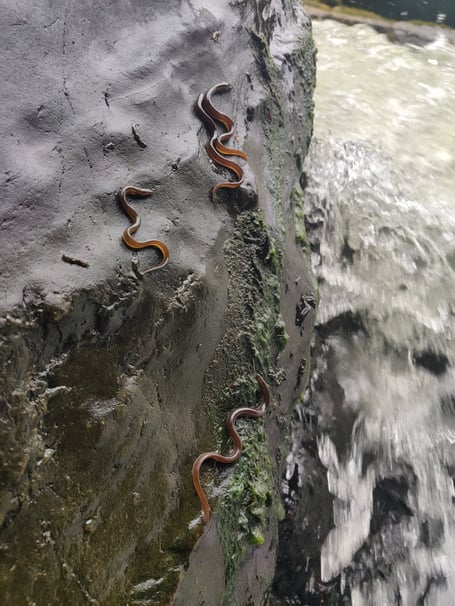Incredible footage of baby eels climbing up rocks and a spawning prehistoric parasitic creature - with a fearsome jawless sucker mouth - has been captured in the Teifi River.
Lampreys, that can grow up to one metre in length, are nocturnal and are rarely seen by the public except at spawning time when temperatures are hot enough to move into shallow waters in broad daylight to start building their nests.
West Wales Rivers Trust restoration officer Nathaniel James saw them in the Teifi near Cenarth Falls near Newcastle Emlyn. He also saw young eels (elvers) making their way upstream by climbing up wet moss and algae further up the river.
Baby eels spotted climbing rocks in the Teifi River (Nathaniel James/West Wales River Trust)
Having been in existence for over 360 million years, well before the dinosaurs, lamprey numbers are now in decline in the UK. Brook, river and sea lamprey are known to frequent the rivers of Wales.
But the climate crisis, and issues such as pollution, habitat destruction, and obstacles like weirs and dams, are all having a major impact on their populations, along with other freshwater species.
Mr James said: “I managed to spot these spawning mating lampreys whilst leading a guided river walk!
Spawning lamprey spotted in the Teifi River (Credit: Nathaniel James/West Wales Riverst Trust)
“It is a glimmer of hope to see these increasingly rare fish species still present in the Teifi, it reminds us that they will respond to improvements made to river habitat and water quality.
“It is also worth noting that despite the eels' incredible ability to navigate these tricky natural barriers, many human modifications to the river and floodplain habitats that they utilize threaten eel populations across Wales.
“The Lamprey has been swimming in rivers longer than the current post-glacial Teifi has existed. Despite their drab appearance in comparison to other fish, one can't be but in awe of their time-proven adaptations.”
Lampreys move stones with their mouth to create a nest in the riverbed and begin spawning. The females will lay up to 1,500 eggs, which can be seen in the video as tiny white dots settled amongst the stones.
After a restoration project in the River Dee, Natural Resources Wales project manager Joel Rees-Jones said: “Lampreys are one of the key species our project is focusing on, so we were delighted to witness them spawning as we carried out fish tagging work in the upper Dee.
“Like salmon, and many other fish, lamprey populations are fighting for survival and urgent action is needed to reverse their decline.
“Our project aims to restore the river to a more natural state, removing physical barriers which prevent fish migrating downstream to the sea and upstream to their spawning grounds, and reinvigorate the ecosystems they all depend upon.”
Brook lamprey measure around 15cm long and remain in freshwater for their entire lives, living for 3-7 years in silty areas of the river. Once in their adult form, they stop feeding completely, and die shortly after spawning.
River and sea lamprey are much larger in size, around 30cm and 1m respectively, and travel downstream to the sea to feed before returning to the river to spawn in May and June, laying between 25,000 to 30,000 eggs.





Comments
This article has no comments yet. Be the first to leave a comment.